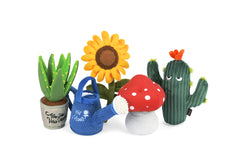Our team at Tuft and Paw includes a veterinarian and a cat behaviorist, so naturally we know a lot about cat behavior. We just finished our definitive guide to cat body language, but we’ve partnered with PetPlay to create a quick summary of some the most important cat cues.
Cats have evolved to communicate much differently than us. It can make understanding their moods pretty frustrating for many new cat parents.
Novice cat owners may try to rely on their cat’s vocal cues at first. After all, we humans are all about verbal communication. And although cats do communicate through hisses, trills, meows, and growls, the various sounds can have different meanings depending on the circumstances.
Therefore the best way to understand what your cat is trying to tell you is to read their physical cues. Here’s what you need to know in order to decode your cat’s body language:
Learning the language
Before you can read your cat’s mood, you need to be able to understand their language. Your cat’s eyes, ears, body, tail, and even their whiskers all work together to send you a message.
Look at each indicator to piece together how your cat is feeling - think of them like letters of the cat alphabet.
Eyes

- Wide eyes with dilated pupils means your cat is stimulated. Either they’re afraid or they see something they’re about to pounce on.
- Narrow, slit-like eyes typically suggest aggression or annoyance.
- Lazy, slow-blinking eyes are a sign of comfort and affection. (Try slow-blinking back to your cat to bond with them!)
Ears
- Perked ears signify alertness or curiousity, while ears tilted forward suggest confidence and comfort.
- Flattened ears towards the back or side of the head (aka “airplane ears”) indicate fear or aggression.
Body
If a cat positions the side of their body towards you and arches their back, that’s a sign of aggression or fear. They’re trying to make themselves seem bigger to intimidate the threat!
A cat crouched low to the ground is a sign they feel may need to spring into action, either away from a threat or in pursuit of prey. This posture is either a sign of fear or play.
If the cat is facing you head on with a neutral back, they may be feeling friendly and even receptive to petting.
Tail

- A highly-held tail typically depicts happiness and comfort in their surroundings, while a tucked tail suggests fear or anxiety.
- A swishing or flicking tail clearly indicates that they’re annoyed and that you should keep your distance.
Whiskers
Whiskers aren’t as telling as the other indicators, but can still lend subtle clues about what your cat is feeling. Confident, happy cats will push their whiskers forward, while fearful, anxious cats will pull their whiskers back in attempt to make themselves smaller.
Putting it into context
Since each indicator can translate into a number of contrasting moods, it’s not enough to look at just one to determine what your cat is trying to communicate. You’ll need to factor all of them together to give them context.
For example, if your cat’s tail is held high in the air, is it because they’re happy and confident, or because their feeling aggressive?
Are they arching their back because their angry and afraid, or are they simply stretching?
Checking the rest of the indicators will give you the whole picture; a wide-eyed stare with slit pupils and ears flat against the head means they are clearly aggressive.
Factoring in your cat’s personality
Cat’s are just like people in that they all have their own unique characteristics. Some cats are known to be cuddly while others prefer more space.
Ongoing interaction with your cat will help you read their physical cues better naturally over time.
For example, if your cat laying on his or her back you may wonder if it’s safe to pet them. Are they welcoming a tummy rub or will they only curl shut on your hand with claws and teeth out, like a Venus Fly Trap?
The physical cues are extremely similar, so how can you tell the difference? Consider what know about your cat’s personality to help you put into context whether your cat is inviting you to pet their tummy - or daring you to!
Patience makes perfect
Understanding your cat’s personality and physical cues can take time. It’s not a perfect science because every cat is unique. Be cautious when you’re getting to know your cat, and try not to get frustrated; they’re likely having just as much trouble understanding you!
But with time, practice, and patience, you’ll be able to read their body language cues more clearly and will develop a happier bond with your cat.







